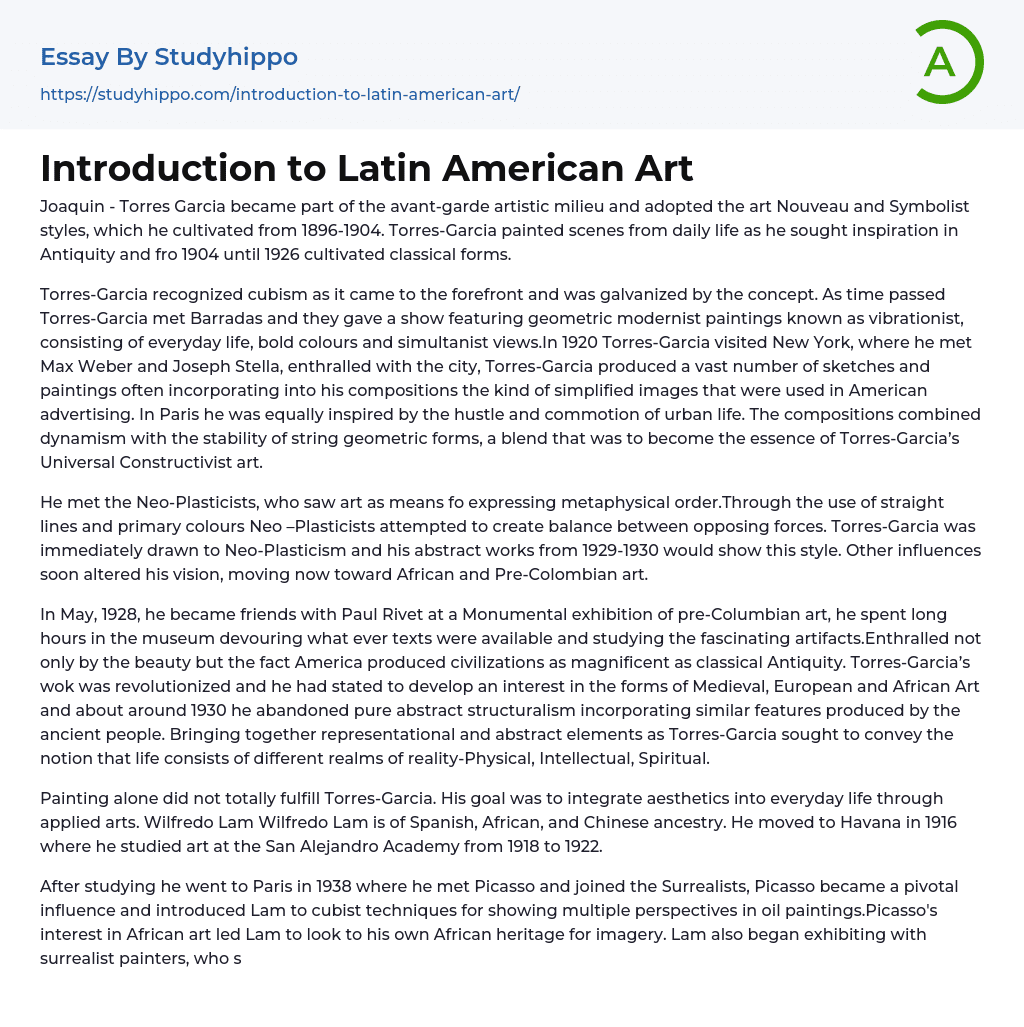Joaquin-Torres Garcia was involved in the avant-garde art scene, where he embraced the styles of Art Nouveau and Symbolism. He developed these styles between 1896 and 1904 while incorporating scenes from everyday life and drawing inspiration from Antiquity. From 1904 to 1926, he shifted towards classical forms.
Torres-Garcia embraced the emergence of cubism and was energized by the concept. Later, Torres-Garcia collaborated with Barradas to showcase vibrationist paintings that utilized everyday life, bold colors, and simultanist perspectives. During a visit to New York in 1920, Torres-Garcia encountered Max Weber and Joseph Stella. He produced an abundance of sketches and paintings that incorporated simplified images often found in American advertising. While in Paris, Torres-Garcia found inspiration in the buzzing chaos of urban life. His compositions blended dynamism with stable geometric forms, a fusion that would define Torres-Garcia’s Universal Constructivist art.
...
Having encountered the Neo-Plasticists, Torres-Garcia became enamored with their belief that art could convey metaphysical order by employing primary colors and straight lines to establish equilibrium amid contrary forces. With this style in mind, he created a series of abstract pieces in 1929-1930. However, his perspective shifted when he encountered African and Pre-Colombian art.
During a Monumental exhibition of pre-Columbian art in May 1928, Torres-Garcia made friends with Paul Rivet. He spent countless hours in the museum devouring texts and studying fascinating artifacts, finding himself enraptured not only by their beauty but also by the fact that America produced civilizations as magnificent as classical Antiquity. This experience revolutionized Torres-Garcia's work, leading him to develop an interest in Medieval, European, and African Art. By around 1930, he abandoned pure abstract structuralism and incorporated similar features produced by ancient people. Torres-Garcia
brought together representational and abstract elements to convey the idea that life consists of different realms of reality-physical, intellectual, and spiritual.
Although painting by itself did not fully satisfy him, Torres-Garcia aimed to incorporate aesthetic principles into daily life through the utilization of applied arts. Meanwhile, Wilfredo Lam, a fellow artist with a diverse heritage encompassing Spanish, African, and Chinese roots, resided in Havana from 1916 and participated in art education at the San Alejandro Academy between 1918 and 1922.
Following his studies, Lam travelled to Paris in 1938 where he had the opportunity to meet and collaborate with Picasso, as well as join the Surrealists. With Picasso's guidance, Lam explored cubist techniques that allowed for a range of perspectives in oil painting. Additionally, Picasso's appreciation for African art prompted Lam to incorporate his own African heritage into his artwork. Lam exhibited alongside other surrealist painters who aimed to capture the workings of the subconscious in their creations. Lam had been inspired by Picasso's work a year prior after attending an exhibition in Madrid.
Largely influenced by Picasso, Lam gained support from many leading artists of his time including Fernand Leger, Henri Matisse, Georges Braque and Joan Miro. Motivated by the European modernist interest in African art and culture, Lam began to examine his own roots. Upon returning to Cuba in 1941, he skillfully fused black iconography with imagery from the Cuban Santeria religion, utilizing European avant-garde techniques to create works such as The Jungle. Lam's oil paintings harmoniously merge elements of European modernist movements with representations from African cultures. His stylized figures bear a resemblance to those of Picasso. In 1938, his emotional intensity
was evident in works that featured everything from intimate couples to distressed women. These works also demonstrated a notably stronger African influence through their figures' angular outlines and the synthesis of their bodies.
Throughout his lengthy and fruitful career, Wifredo Lam's artistic style and iconography developed steadily towards greater simplicity and abstraction, occasionally approaching a decorative aesthetic. Starting in the late 1950s, he shifted his focus towards graphic design and ceramics. Lam's art gained national recognition in the 1940s and eventually earned him international acclaim. His 1942 masterpiece, "The Jungle," represents the pinnacle of the artist's mature style.
The artwork of Lam is famous for its polymorphism, which combines features of humans, animals, and plants to create strange and hybrid creatures. One characteristic of these figures is their distorted human forms, with faces that resemble African masks, highlighting the weight of cultural influences. The figures are depicted with long limbs viewed from multiple angles and seamlessly blend in with the lush flora of a tropical forest. This dense composition evokes a sense of claustrophobia, with the forms appearing indistinct. The extended limbs of the figures lack definitive shapes, while their large feet, round buttocks, and masked heads reflect African inspiration. The iridescent quality of these forms also adds to the tropical atmosphere of the painting and suggests the painter’s heritage and culture. Despite this association with Africa, Lam’s Jungle painting did not intend to portray Cuba as primitive.
Lam aimed to portray a spiritual condition influenced by Santeria rather than to exploit Afro-Cuban culture for tourism. He used his powerful work as a means to accurately depict the reality of his people, gaining both recognition and admiration.
- Design essays
- Graffiti essays
- Graphic essays
- Typography essays
- Painting essays
- Photography essays
- Sculpture essays
- Architecture essays
- Interior design essays
- Arch essays
- Area essays
- Aesthetics essays
- Art History essays
- Artist essays
- ballet essays
- Body Art essays
- Color essays
- Concert Review essays
- Creativity essays
- Cultural Anthropology essays
- Ethnography essays
- Harlem Renaissance essays
- Heritage essays
- Modernism essays
- Mona Lisa essays
- Pastoral essays
- Postmodernism essays
- Realism essays
- Symbolism essays
- Theatre essays
- Visual Arts essays
- Voice essays
- Work of art essays
- Alaska essays
- Boston essays
- Brazil essays
- California essays
- Canada essays
- Chicago essays
- Costa Rica essays
- Florida essays
- Hawaii essays
- Latin America essays
- Los Angeles essays
- Mexico essays
- Slavery In America essays
- Usa essays
- Virginia essays
- Washington essays




